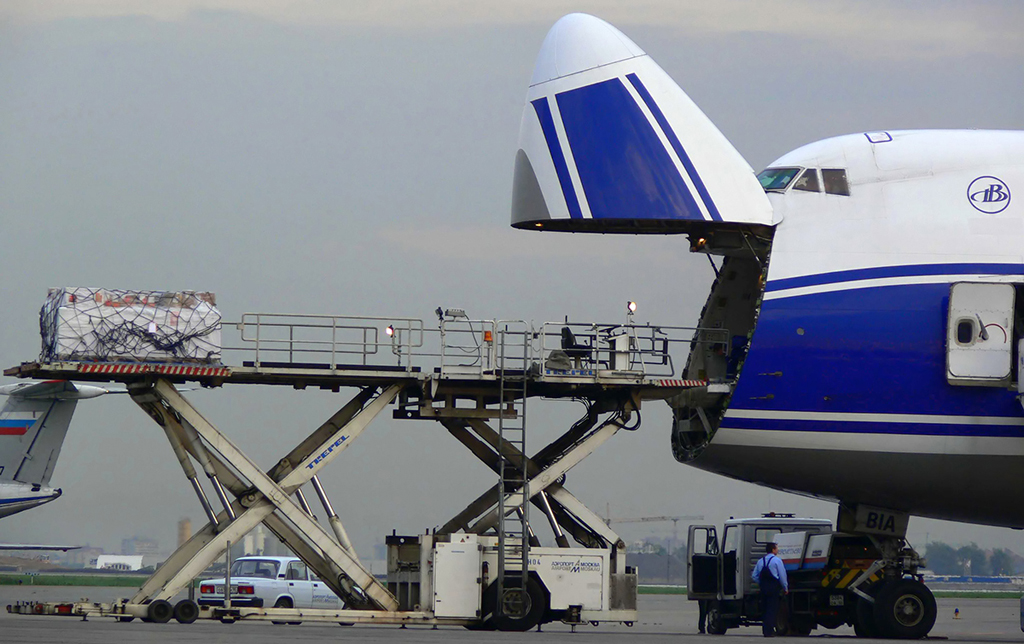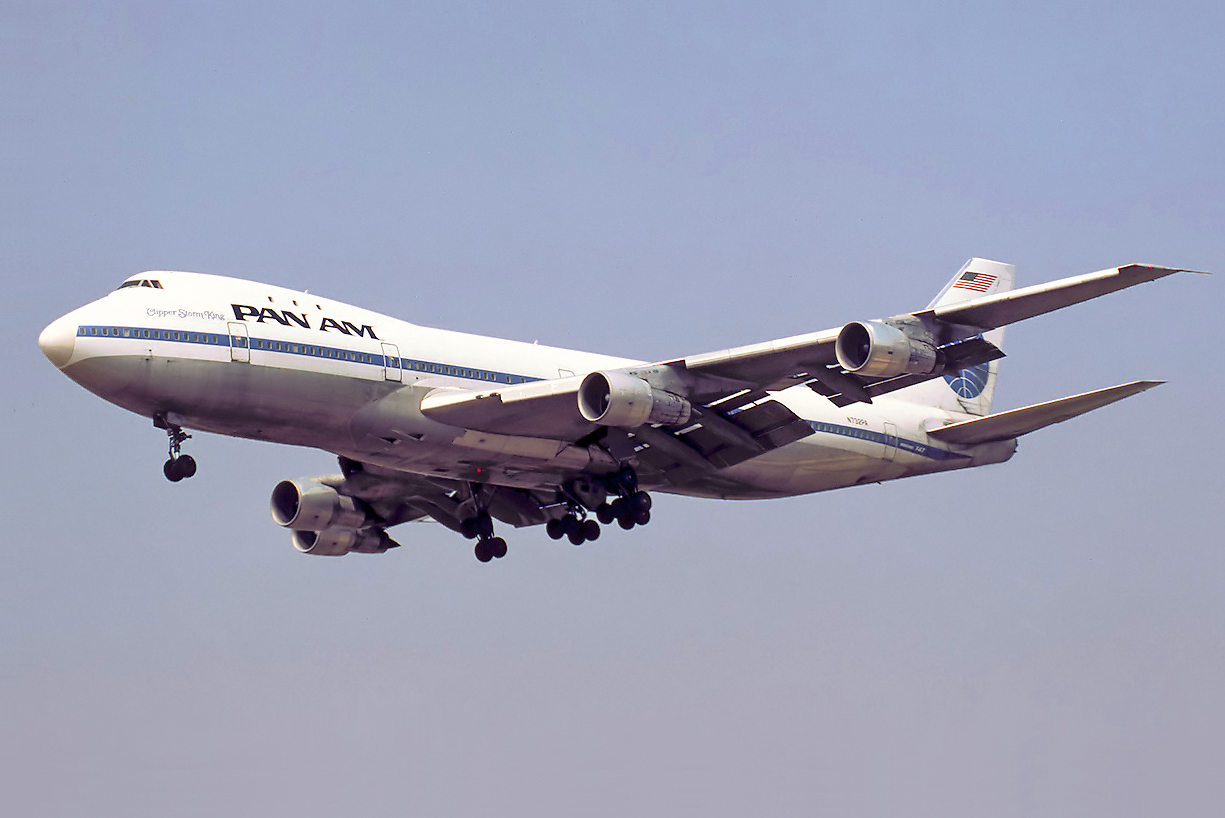|
Boeing 747
The Boeing 747 is a large, long-range wide-body airliner designed and manufactured by Boeing Commercial Airplanes in the United States between 1968 and 2022. After introducing the 707 in October 1958, Pan Am wanted a jet times its size, to reduce its seat cost by 30%. In 1965, Joe Sutter left the 737 development program to design the 747, the first twin-aisle airliner. In April 1966, Pan Am ordered 25 Boeing 747-100 aircraft and in late 1966, Pratt & Whitney agreed to develop the JT9D engine, a high-bypass turbofan. On September 30, 1968, the first 747 was rolled out of the custom-built Everett Plant, the world's largest building by volume. The first flight took place on February 9, 1969, and the 747 was certified in December of that year. It entered service with Pan Am on January 22, 1970. The 747 was the first airplane dubbed "Jumbo Jet", the first wide-body airliner. The 747 is a four-engined jet aircraft, initially powered by Pratt & Whitney JT9D turbof ... [...More Info...] [...Related Items...] OR: [Wikipedia] [Google] [Baidu] |
Wide-body Aircraft
A wide-body aircraft, also known as a twin-aisle aircraft, is an airliner with a fuselage wide enough to accommodate two passenger aisles with seven or more seats abreast. The typical fuselage diameter is . In the typical wide-body economy cabin, passengers are seated seven to ten abreast, allowing a total capacity of 200 to 850 passengers. The largest wide-body aircraft are over wide, and can accommodate up to eleven passengers abreast in high-density configurations. By comparison, a typical narrow-body airliner has a diameter of , with a single aisle, and seats between two and six people abreast. Wide-body aircraft were originally designed for a combination of efficiency and passenger comfort and to increase the amount of cargo space. However, airlines quickly gave in to economic factors, and reduced the extra passenger space in order to insert more seats and increase revenue and profits. Wide-body aircraft are also used for the transport of commercial freight and cargo an ... [...More Info...] [...Related Items...] OR: [Wikipedia] [Google] [Baidu] |
Boeing 747SP
The Boeing 747SP (for ''Special Performance'') is a shortened version of the Boeing 747 wide-body airliner, designed for a longer range. Boeing needed a smaller aircraft to compete with the McDonnell Douglas DC-10 and Lockheed L-1011 TriStar tri-jet wide-bodies, introduced in 1971/1972. Pan Am requested a 747-100 derivative to fly between New York and the Middle East, a request also shared by Iran Air, and the first order came from Pan Am in 1973. The variant first flew on July 4, 1975, was approved by the Federal Aviation Administration on February 4, 1976, and entered service that year with Pan Am. The SP is in length, shorter than the original 747 variants. Its main deck doors are reduced to four on each side to suit its lower capacity. The vertical and horizontal tailplane are larger and its wing flaps have been simplified. With a maximum take-off weight, it can fly 276 passengers in three classes over . One 747SP was modified into the Stratospheric Observatory for ... [...More Info...] [...Related Items...] OR: [Wikipedia] [Google] [Baidu] |
Quadjet
A four-engined jet, sometimes called a quadjet, is a jet aircraft powered by four engines. The presence of four engines offers increased power, allowing such aircraft to be used as airliners, freighters, and military aircraft. Many of the first purpose-built jet airliners had four engines, among which stands the De Havilland Comet, the world's first commercial jetliner. In the decades following their introduction, their use has gradually declined due to a variety of factors, including the approval of twin-engine jets to fly farther from diversion airports as reliability increased, and an increased emphasis on fuel efficiency. Design Podded engines The engines of a four-engined aircraft are most commonly found in pods hanging from pylons underneath the wings. This can be observed in the Airbus A340, Airbus A380, and Boeing 747. Many military airlifters also feature this design, including the Antonov An-124, Boeing C-17 Globemaster, and Lockheed C-5 Galaxy. In this location ... [...More Info...] [...Related Items...] OR: [Wikipedia] [Google] [Baidu] |
Boeing 747-8
The Boeing 747-8 is a wide-body airliner formerly developed by Boeing Commercial Airplanes, and the largest variant of the 747. After introducing the 747-400, Boeing considered larger 747 versions as alternatives to the proposed double-deck Airbus A3XX, later developed as the A380. The stretched 747 Advanced was launched as the on November 14, 2005, for a market forecast of 300 aircraft. The first 747-8F Freighter performed its maiden flight on February 8, 2010, and the passenger 747-8I Intercontinental followed suit on March 20, 2011. The cargo version was first delivered in October 2011 and the airliner began commercial service in June 2012. Its fuselage is stretched by to , making it the longest airliner until the 777X, which first flew in 2020. While keeping its basic structure and sweep, the wing is thicker and deeper, holding more fuel, and wider with raked wingtips. Powered more efficiently than preceding 747s by a smaller version of the General Electric GEnx ... [...More Info...] [...Related Items...] OR: [Wikipedia] [Google] [Baidu] |
Boeing 707
The Boeing 707 is an American, long-range, narrow-body airliner, the first jetliner developed and produced by Boeing Commercial Airplanes. Developed from the Boeing 367-80 prototype first flown in 1954, the initial first flew on December 20, 1957. Pan American World Airways began regular 707 service on October 26, 1958. With versions produced until 1979, the 707 was a swept wing, quadjet with podded engines. Its larger fuselage cross-section allowed six-abreast economy seating, retained in the later 720, 727, 737, and 757 models. Although it was not the first commercial jetliner in service, the 707 was the first to be widespread and is often credited with beginning the Jet Age. It dominated passenger air transport in the 1960s, and remained common through the 1970s, on domestic, transcontinental, and transatlantic flights, as well as cargo and military applications. It established Boeing as a dominant airliner manufacturer with its 7x7 series. The initial, w ... [...More Info...] [...Related Items...] OR: [Wikipedia] [Google] [Baidu] |
Joe Sutter
Joseph Frederick Sutter (March 21, 1921 – August 30, 2016) was an American engineer for the Boeing Airplane Company and manager of the design team for the Boeing 747 under Malcolm T. Stamper, the head of the 747 project. '' Air & Space/Smithsonian'' magazine has described Sutter as the "father of the 747". Early life and education Sutter was born in Seattle, Washington, and grew up in the vicinity of Boeing's Seattle plant. He was of Slovenian descent—his father, Franc Suhadolc (1879–1945) from Dobrova, Slovenia, came to America as a gold prospector. Sutter attended the University of Washington and graduated with a bachelor's degree in aeronautical engineering in 1943. Career In 1940, Sutter took a summer job at Boeing Plant 2 while studying aeronautical engineering at the University of Washington. Sutter served as a junior officer aboard the destroyer escort in the U.S. Navy during World War II. He was a young U.S. Navy veteran finishing his degree when both ... [...More Info...] [...Related Items...] OR: [Wikipedia] [Google] [Baidu] |
Boeing 737
The Boeing 737 is a narrow-body aircraft produced by Boeing at its Renton Factory in Washington. Developed to supplement the Boeing 727 on short and thin routes, the twinjet retains the 707 fuselage width and six abreast seating with two underwing turbofans. Envisioned in 1964, the initial 737-100 made its first flight in April 1967 and entered service in February 1968 with Lufthansa. The lengthened 737-200 entered service in April 1968, and evolved through four generations, offering several variants for 85 to 215 passengers. The 737-100/200 original variants were powered by Pratt & Whitney JT8D low-bypass engines and offered seating for 85 to 130 passengers. Launched in 1980 and introduced in 1984, the 737 Classic -300/400/500 variants were upgraded with CFM56-3 turbofans and offered 110 to 168 seats. Introduced in 1997, the 737 Next Generation (NG) -600/700/800/900 variants have updated CFM56-7s, a larger wing and an upgraded glass cockpit, and seat 108 to 215 pa ... [...More Info...] [...Related Items...] OR: [Wikipedia] [Google] [Baidu] |
Iberia (airline)
Iberia (), legally incorporated as ''Iberia Líneas Aéreas de España, S.A. Operadora, Sociedad Unipersonal'', is the flag carrier airline of Spain. Founded in 1927 and based in Madrid, it operates an international network of services from its main base of Adolfo Suárez Madrid–Barajas Airport, Madrid–Barajas Airport. Iberia, with Iberia Regional (operated by an independent carrier Air Nostrum) and with Iberia Express, is a part of International Airlines Group. In addition to transporting passengers and freight, Iberia Group carries out related activities, such as aircraft maintenance, handling in airports, IT systems and in-flight catering. Iberia Group airlines fly to over 109 destinations in 39 countries, and a further 90 destinations through code-sharing agreements with other airlines. On 8 April 2010, it was confirmed that British Airways and Iberia had signed an agreement to merge, making the combined operation the third largest commercial airline in the world by re ... [...More Info...] [...Related Items...] OR: [Wikipedia] [Google] [Baidu] |
Pratt & Whitney
Pratt & Whitney is an American aerospace manufacturer with global service operations. It is a subsidiary of Raytheon Technologies. Pratt & Whitney's aircraft engines are widely used in both civil aviation (especially airlines) and military aviation. Its headquarters are in East Hartford, Connecticut.Contact Us ." Pratt & Whitney. Retrieved on January 7, 2011. "Corporate Headquarters Pratt & Whitney 400 Main Street East Hartford, CT 06108." As one of the "big three" aero-engine manufacturers, it competes with and , although it has also formed joint ventures wit ... [...More Info...] [...Related Items...] OR: [Wikipedia] [Google] [Baidu] |
High-bypass Turbofan
The turbofan or fanjet is a type of airbreathing jet engine that is widely used in aircraft propulsion. The word "turbofan" is a portmanteau of "turbine" and "fan": the ''turbo'' portion refers to a gas turbine engine which achieves mechanical energy from combustion, and the ''fan'', a ducted fan that uses the mechanical energy from the gas turbine to force air rearwards. Thus, whereas all the air taken in by a turbojet passes through the combustion chamber and turbines, in a turbofan some of that air bypasses these components. A turbofan thus can be thought of as a turbojet being used to drive a ducted fan, with both of these contributing to the thrust. The ratio of the mass-flow of air bypassing the engine core to the mass-flow of air passing through the core is referred to as the bypass ratio. The engine produces thrust through a combination of these two portions working together; engines that use more jet thrust relative to fan thrust are known as ''low-bypass turbofans'', ... [...More Info...] [...Related Items...] OR: [Wikipedia] [Google] [Baidu] |









